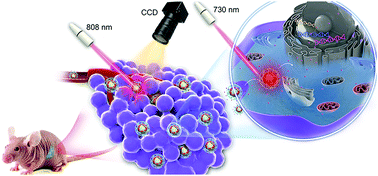Theranostic nanoparticles enabling the release of phosphorylated gemcitabine for advanced pancreatic cancer therapy†
Abstract
Gemcitabine (GEM) has been the recommended first-line drug for patients with pancreatic ductal adenocarcinoma cancer (PDAC) for the last twenty years. However, GEM-based treatment has failed in many patients because of the drug resistance acquired during tumorigenesis and development. To override resistance to GEM in pancreatic cancer, we developed a visualisable, photothermally controlled, drug release nanosystem (VPNS). This nanosystem has NaLuF4:Nd@NaLuF4 nanoparticles as the luminescent core, octabutoxyphthalocyanine palladium(II) (PdPc) as the photothermal agent, and phosphorylated gemcitabine (pGEM) as the chemodrug. pGEM, one of the active forms of GEM, can circumvent the insufficient activation of GEM in cancer cell metabolism. The NaLuF4:Nd@NaLuF4 nanoparticles were employed to visualise the tumor lesion in vivo by their near-infrared luminescence. The near-infrared light-triggered photothermal effect from PdPc could trigger the release of pGEM loaded in a thermally responsive ligand and simultaneously enable photothermal cancer treatment. This work presents an effective method that suppresses the growth of tumour cells with dual-mode treatment and enables the improved treatment of orthotopic nude mice afflicted with pancreatic cancer.



 Please wait while we load your content...
Please wait while we load your content...